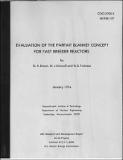Evaluation of the parfait blanket concept for fast breeder reactors
Author(s)
Ducat, Glenn Alexander; Driscoll, Michael J.; Todreas, Neil E.
Download856904466.pdf (11.53Mb)
Other Contributors
Massachusetts Institute of Technology. Department of Nuclear Engineering
U.S. Atomic Energy Commission
United States. Department of Energy
Metadata
Show full item recordAbstract
An evaluation of the neutronic, thermal-hydraulic, mechanical and economic characteristics of fast breeder reactor configurations containing an internal blanket has been performed. This design, called the parfait blanket concept, employs a layer of axial blanket fuel pellets at the core midplane in the fuel pins of the inner enrichment zone; otherwise, the design is the same as that of the conventional LMFBR's to which the parfait configuration was compared. Two significant advantages were identified for the parfait blanket concept relative to the conventional design. First, the parfait configuration has a 25% smaller peak fast flux which reduces wrapper tube dilation by 37% and fuel element elongation by 29%; and second, axial and radial flux flattening contribute to a 7. 6% reduction in the peak fuel burnup. Both characteristics significantly diminish the problems of fuel and metal swelling. Other advantages identified for a typical parfait design include: a 25% reduction in the burnup reactivity swing, which reduces control rod requirements; a 7% greater overpower operating margin; an increased breeding ratio, which offsets the disadvantage of a higher critical mass; and more favorable sodium voiding characteristics which counteract the disadvantage of an 8% smaller power Doppler coefficient. All other characteristics investigated were found to differ insignificantly or slightly favor the parfait design.
Description
"January 1974." Also issued as a Ph. D. thesis by the first author and supervised by the second and third author, MIT, Dept. of Nuclear Engineering, 1974 Includes bibliographical references (pages 261-264)
Date issued
1974Publisher
Cambridge, Mass. : Massachusetts Institute of Technology, Dept. of Nuclear Engineering, [1974]
Series/Report no.
MITNE ; no. 157AEC research and development reportCOO (Series) ; 2250-5